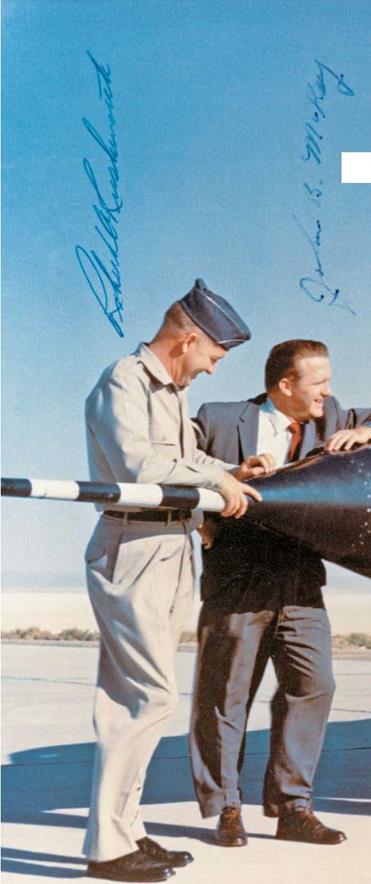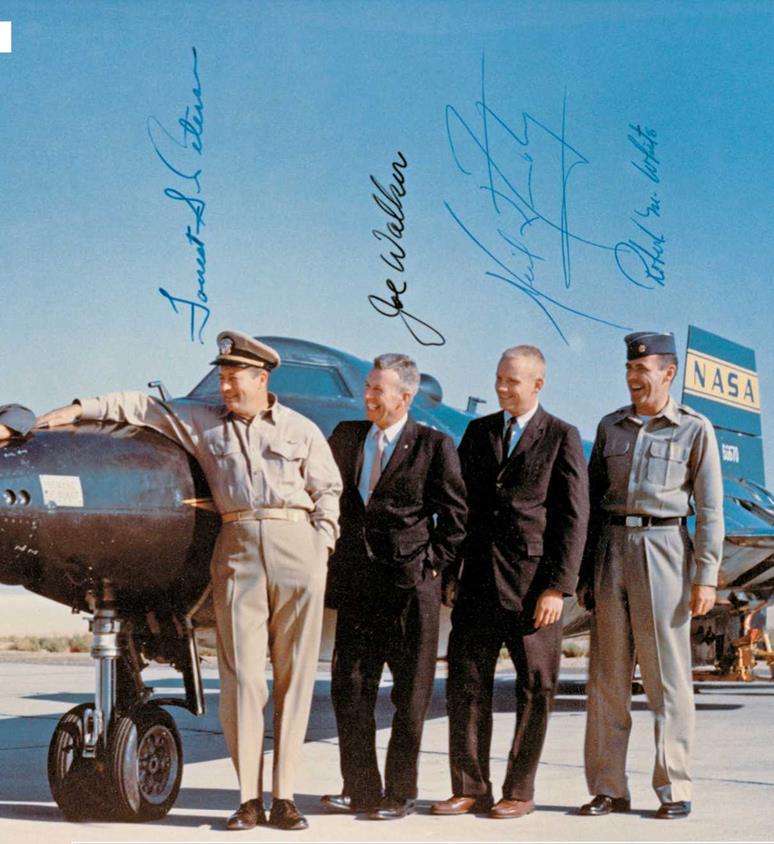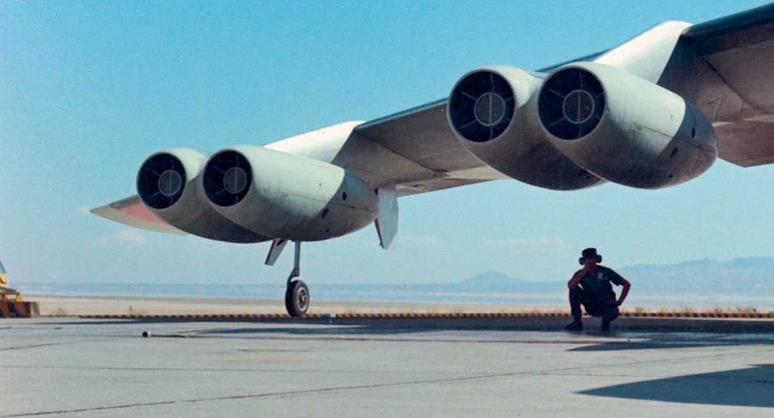MICHAEL J. ADAMS
1930-1967
Mike Adams was the twelfth (and last) pilot in the program, and he was the only pilot to lose his life flying the X-15.
On November 15, 1967, Michael Adams, veteran pilot with six previous X-15 flights, entered the aircraft for a flight to evaluate a guidance display and to conduct several experiments. He had spent more than 21 hours practicing the specifics of this flight in the simulator. The drop at about 10 a. m. and 45,000 feet was normal, and he climbed to 266,000 feet. While the aircraft climbed to higher altitude after launch, an electrical disturbance caused the MH – 96 dampers to trip out. Adams reset the dampers. He then switched the sideslip indicator to a vernier

attitude control mode to more accurately control the experiments. He planned to reset this back to indicate yaw angle when returning to base in order to see his sideslip during approach to landing. But this instrument change prevented him from seeing that the airplane was yawing at a critical time in the flight.
After burnout, as he soared upward, he conducted a wing-rocking experiment, in which the rocking became excessive as he approached his peak altitude, 266,000 feet. His yaw had drifted to 15 degrees, and he was unaware of this because his instrument was inadvertently set to show pitch attitude, not yaw. About 15 seconds later, the airplane was yawing wildly and Adams
communicated to Pete Knight that “the airplane seems squirrelly.” He soon after stated that he was in a spin, subjected to high accelerations. Since little was known about the hypersonic spin characteristics of the airplane, the ground crew was not able to offer advice. According to the ground data that was later correlated with the flight data, when Adams recovered, he was yawed 90 degrees, flying upside down, and descending at supersonic speed.
Adams pulled out of the spin, and he probably would have had a successful landing except that the MH-96, the Minneapolis-Honeywell adaptive flight control system, was on and locked in, causing the airplane to oscillate between its limits,

up and down, preventing Adams from correcting his attitude and flying his way home. The loads on the airplane built up beyond the structural limits, and the X-15-3 aircraft broke up at approximately 62,000 feet and about 3,800 feet-per-second speed. It crashed to the desert floor near Johannesburg, California. There was talk about Adams having slight vertigo, which may have contributed to his not noticing the yaw buildup or resetting the yaw indicator to the yaw setting.
Adams’s death shows the dangers of flight testing a new aircraft in previously untested regions of flight, and of flying experiments in which certain research-data measuring instruments may have caused an electrical
disturbance that affected the MH-96 from operating at its top quality and in conditions it was not designed for. Any and all these things may have influenced the accident.
Because his flight was above 50 miles high, Adams was posthumously awarded an astronaut rating. For the X-15 program, the tragedy was a blight, but it was the only casualty in 199 flights. Since the objectives for the airplane had been accomplished, the accident was a major reason for the termination of the X-15 program. There were only seven subsequent flights.
Michael Adams was born on May 5, 1930, in Sacramento, California. After graduating from Sacramento Junior College, he enlisted in the Air
 |
The rotational motion of an airplane in flight takes place centered around the airplane’s center of gravity. It is a combination of three rotational directions: the nose up or down rotation, called pitch; the wing rotation about the fuselage, called roll; and the nose swinging right or left, called yaw.
Force in November 1950. The Korean War was in full force at that time, and Adams flew forty – nine combat missions as a fighter-bomber pilot in Korea. In 1958, he earned an aeronautical engineering degree from the University of Oklahoma, and he went on to eighteen months of study at MIT in astronautics. In 1962, he was selected to attend the Experimental Test Pilot School at Edwards Air Force Base. He excelled at the school, winning the Honts Trophy as the best scholar and pilot in his class. In December 1963, he graduated with honors from the Aerospace Research Pilot School. His first flight in the X-15 was on October 6, 1966. On June 8, 2004, a memorial monument to Adams was erected near the crash site, northwest of Randsburg, California.
Test pilots are a special breed. They face risks above and beyond those faced by conventional pilots. The X-15 pilots, however, are in a special class. They were research test pilots, putting their lives on the line to prove the viability of a pioneering hypersonic airplane and to obtain research data on an unknown regime of flight.
This data was invaluable to the subsequent design of the Space Shuttle.
 On almost every flight of the X-15, some type of technical problem or failure occurred, sometimes multiple problems on the same flight.
On almost every flight of the X-15, some type of technical problem or failure occurred, sometimes multiple problems on the same flight.
|

|

|
|
 X-15 on the lakebed of Rogers Dry Lake. USAF, Air Force Flight Test Center History Office, Edwards Air Force Base
X-15 on the lakebed of Rogers Dry Lake. USAF, Air Force Flight Test Center History Office, Edwards Air Force Base
It is remarkable that only one pilot, Mike Adams lost his life during the whole X-15 program of 199 flights. Ten of the twelve had formal college degrees in aeronautical engineering and took pride in their status as dedicated, professional aeronautical engineers. All served at one time or another in the military, and six (Crossfield, Walker, McKay, Armstrong, Thompson, and Dana) were in civilian status when they flew the X-15. Of the career military officers who flew the X-15, three retired as major generals in the Air Force and one as a vice admiral in the Navy.
|













